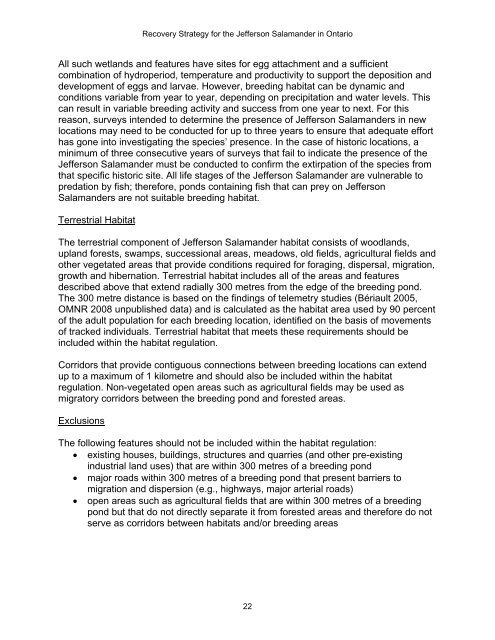Jefferson Salamander - Amphibian Specialist Group
Jefferson Salamander - Amphibian Specialist Group
Jefferson Salamander - Amphibian Specialist Group
You also want an ePaper? Increase the reach of your titles
YUMPU automatically turns print PDFs into web optimized ePapers that Google loves.
Recovery Strategy for the <strong>Jefferson</strong> <strong>Salamander</strong> in OntarioAll such wetlands and features have sites for egg attachment and a sufficientcombination of hydroperiod, temperature and productivity to support the deposition anddevelopment of eggs and larvae. However, breeding habitat can be dynamic andconditions variable from year to year, depending on precipitation and water levels. Thiscan result in variable breeding activity and success from one year to next. For thisreason, surveys intended to determine the presence of <strong>Jefferson</strong> <strong>Salamander</strong>s in newlocations may need to be conducted for up to three years to ensure that adequate efforthas gone into investigating the species’ presence. In the case of historic locations, aminimum of three consecutive years of surveys that fail to indicate the presence of the<strong>Jefferson</strong> <strong>Salamander</strong> must be conducted to confirm the extirpation of the species fromthat specific historic site. All life stages of the <strong>Jefferson</strong> <strong>Salamander</strong> are vulnerable topredation by fish; therefore, ponds containing fish that can prey on <strong>Jefferson</strong><strong>Salamander</strong>s are not suitable breeding habitat.Terrestrial HabitatThe terrestrial component of <strong>Jefferson</strong> <strong>Salamander</strong> habitat consists of woodlands,upland forests, swamps, successional areas, meadows, old fields, agricultural fields andother vegetated areas that provide conditions required for foraging, dispersal, migration,growth and hibernation. Terrestrial habitat includes all of the areas and featuresdescribed above that extend radially 300 metres from the edge of the breeding pond.The 300 metre distance is based on the findings of telemetry studies (Bériault 2005,OMNR 2008 unpublished data) and is calculated as the habitat area used by 90 percentof the adult population for each breeding location, identified on the basis of movementsof tracked individuals. Terrestrial habitat that meets these requirements should beincluded within the habitat regulation.Corridors that provide contiguous connections between breeding locations can extendup to a maximum of 1 kilometre and should also be included within the habitatregulation. Non-vegetated open areas such as agricultural fields may be used asmigratory corridors between the breeding pond and forested areas.ExclusionsThe following features should not be included within the habitat regulation:• existing houses, buildings, structures and quarries (and other pre-existingindustrial land uses) that are within 300 metres of a breeding pond• major roads within 300 metres of a breeding pond that present barriers tomigration and dispersion (e.g., highways, major arterial roads)• open areas such as agricultural fields that are within 300 metres of a breedingpond but that do not directly separate it from forested areas and therefore do notserve as corridors between habitats and/or breeding areas22
















